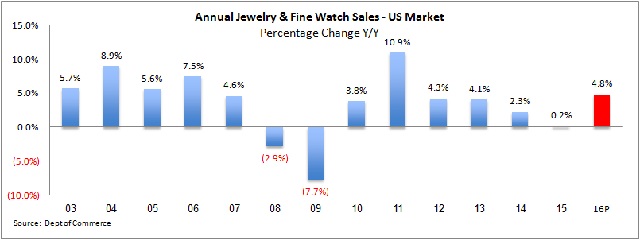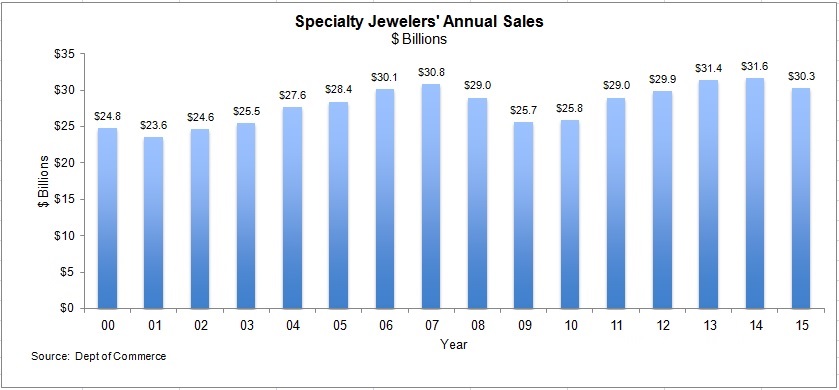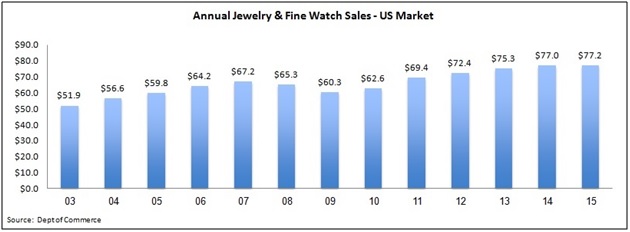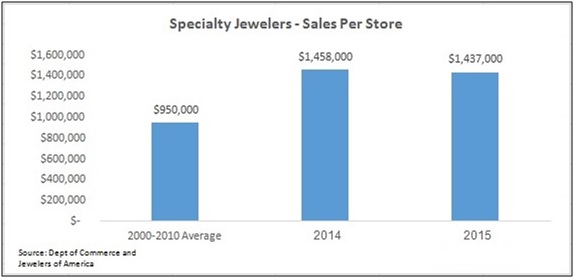U.S. Specialty Jewelers: Still A Good Market Niche
September 27, 16
U.S. Specialty Jewelers: Still A Good Market Niche
Each month, IDEX Research reports sales for the U.S. jewelry industry. And each month it seems we say almost the same thing: specialty jewelers are losing market share.
Does that mean the typical American jewelry store is going the way of the dinosaurs? Does it mean they’ll be gone in a few years? Despite tremendous consolidation in the retail industry – home centers, consumer electronics retailers, office supply merchants, pet supply stores, and the list goes on and on – is there a place for the independent specialty jeweler?
IDEX Research has just completed an analysis of the U.S. specialty jewelry channel of retail distribution – those retail merchants including chains and independents who generate most of their sales from jewelry. From a financial viewpoint, here are the facts:
· Jewelry sales through the specialty jewelry retail channel have been about flat at $30 billion for the past decade in the U.S. market.
· The U.S. fine jewelry and watch industry has grown from about $64 billion to about $77 billion over the past decade, an increase of about 20 percent.
· The number of specialty jewelry stores fell to about 20,700 at the end of 2015, down from about 23,800 ten years ago, a decline of about 13 percent.
· Specialty jewelers’ sales per store are up as much as 40 percent over the past decade, and profits are solid.
What these statistics mean:
· While aggregate sales in the specialty jewelry channel have been static, this group of retailers is losing market share because of the rapid growth of jewelry sales through non-traditional retail channels – mostly multi-line retailers like Walmart, Costco, J.C. Penney, and others as well as online merchants.
· Despite a notable decline in the number of specialty jewelry stores, jewelry sales through this retail channel have remained static, a sign that there is market demand for jewelry sold by chain and independent jewelers.
· As a result of increased sales per jewelry store, most specialty jewelers are posting solid profits primarily as a result of economies of scale.
Specialty Jewelers Have Lost Dramatic Market Share
There’s no question that the specialty jewelry retail category is losing market share. Since the 1970s, specialty jewelers – those retail merchants including chains and independents who generate most of their sales from jewelry – have given up market share to the multi-line merchants like Walmart, J.C. Penney, Costco, and others, as the graph below illustrates. In 1971, specialty jewelers sold 73 percent of all jewelry that was bought by U.S. consumers. By 2015, their market share had dropped to below 40 percent.

U.S. Specialty Jewelers’ Sales Have Been Relatively Flat
Sales generated by U.S. specialty jewelers, including the chains, are at the same level – roughly $30 billion – as they were a decade ago in 2006, as the graph below illustrates.

Total U.S. Jewelry Sales Have Risen
In the meantime, total sales of jewelry to U.S. shoppers rose from $64 billion to $77 billion in the same ten-year period, as the graph below illustrates.

Specialty Jewelers Posting Solid Profits
“But wait,” say many specialty jewelers in the IDEX Research sample. “My sales are up, and profits are strong. Are you sure your numbers are good?” they ask.
Actually, there’s a simple answer to their skepticism: because of the large number of specialty jewelry stores that are closing, there are far fewer stores sharing the remaining jewelry sales through that channel. So, sales per specialty jewelry store are up, and profits are solid due mostly to economies of scale.
The Jewelers Board of Trade reports that the number of active specialty jewelers in the U.S. market has shrunk from 23,778 in 2006 to 20,666 at the end of the first half of 2016, a loss of more than 300 stores per year. At its peak in the late 1980s, there were more than 31,000 specialty jewelry stores in America. In short, over three decades, the industry has lost one-third of its retail outlets.
For many years, the economic model for most specialty jewelers called for sales of about $1.0 million per store. Jewelers of America reported that the average jewelry store in their yearly survey posted annual sales of $900,000 to $1 million for a number of years early in the past decade. However, due to a variety of factors – mostly the large number of store closings – the typical U.S. specialty jeweler now generates sales per store of just over $1.4 million, according to the Department of Commerce. That’s a dramatic 40 percent increase in sales per retail jewelry store. Fortunately, most specialty jewelers have kept their costs low while sales have expanded. As a result, profits remain solid and have grown in some cases.
The graph below illustrates recent trends in sales per store for U.S. specialty jewelers, based on data from the U.S. Department of Commerce and the Jewelers of America.

The Department of Commerce numbers show average sales of just over $1.4 million per specialty jewelry store, others report similar numbers and similar trends.
· The Jewelers of America (JA) Cost of Doing Business Survey shows that the average sales per store was around $1.2 million in 2015, up 20 percent in five years. The JA sample is biased toward smaller independent retailers.
· JA reports that chain jewelers in its sample generated a very high $3.8 million per store in 2015. Again, we are aware that its sample includes some very high volume chain stores.
· Signet Jewelers, which operates a variety of brands including Kay and Zale, reported the following sales per jewelry store in 2015:
o Kay - $2.2 million
o Jared - $4.7 million
o Regionals - $1.3 million
o Zales - $1.5 million
o Regionals (in Zale) - $1.4 million
Summary
In short, those specialty jewelers who remain in the business should do just fine, as long as they hold the line on costs while building sales. We won’t make a prediction for the very long term, but we believe that specialty jewelers have a solid near term future – a decade or more – in the U.S. jewelry market from a financial viewpoint.
Here’s some advice for links in the jewelry distribution chain:
· Manufacturers, producers, and suppliers – While aggregate sales are static for the specialty jewelry channel of the market, it is still extremely large and important. Don’t neglect it.
· Specialty jewelry merchants – Hang on as long as possible. As your competition goes out of business, you’ll pick up a portion of their market share. If you can keep a lid on expenses, the incremental revenue will boost profits substantially.
While the scope of this research did not go beyond the financial analysis, it is important to note that demographic shifts and changes in consumer wants and needs will also favor the long term health of specialty jewelers, in our opinion. A future study will focus on this aspect of the U.S. jewelry market.